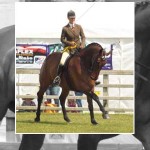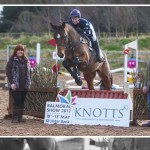Dressage Jargon Demistifyed with Laragh Hamilton
 Picture this scene; you’ve finished your day’s competition, collected your dressage score sheet from the secretary’s office and casually read the comments on the way back to the lorry –What happens next?
Picture this scene; you’ve finished your day’s competition, collected your dressage score sheet from the secretary’s office and casually read the comments on the way back to the lorry –What happens next?
1) Does it make its way into that drawer in the lorry where it will remain until the annual clear out before Tattersalls?
2) Will you disagree profusely with all but positive comments maybe even slipping it into the chip van bin with disregard?
3) Or will you ponder over this new training aid and take constructive comments from your judges’ viewpoint on board aiming to improve your next score?
We spoke to National Irish Dressage Champion, Laragh Hamilton and compiled an A to Z list of dressage judges comments to help you get the most from your dressage score sheet for a more competitive season.
Acceptance: Lack of evasion, resistance or protest – used to describe the horse’s willingness to allow a steady contact or the application of aids.
Balance: Relative distribution of the weight of horse and rider on the fore and hind legs and left and right legs giving longitudinal and lateral balance. / Behind the bit
Contact: The elacticity of the connection between the horse and rider through the reins.
Disunited: Referring to a horse who canters on one lead in front with the other lead behind
Engagement: The push from the hind leg that generates impulsion and lightness
Freedom: The reach, scope and ease of movement of the fore and hind limbs
Holding: When the horse holds a fixed shape in its neck and jaw blocking the riders aids and holding the bit.
Impulsion: the release of energy stored by engagement described by the FEI as the desire to carry itself forward.
Jump: The moment of suspension in the canter
Looseness: The freedom with which the horse travels in a relaxed manner free from tension
Movement: How the horse moves over the ground, judged in part by the rhythm and looseness described above
Nodding: A rhythmic up and down or back and forward motion of the horses head that is not a normal phase of the gait.
Obedience: Willingness demonstrated by the horse to perform the actions requested by the rider.
Pivoting: Avoidance of picking up a foot in the proper rhythm, during walk pirouette movement
Quality: The quality of a gait refers to it’s elasticity, fluency, freedom etc
Relative Straightness: A horse is going straight when the inside leg follows the track of the inside foreleg / Rhythm
Submission: Compliance to the riders aids, and thoroughness. How the horse yields to the riders request within each gait demonstrating confidence and harmony between horse and rider.
Thoroughness: The unblocked flow of energy through the horse allowing the riders aids to reach all parts of the horse.
Uphill: Refers to the horse taking more weight into his hind legs therefore enabling a higher and lighter forehand.
Wide behind: Where the horse travels with hind feed wider apart than the forefeet, most common when evading engagement in lengthening of stride and halt.
X: The Centre point in the arena, generally used for point to halt, accuracy is the key to get higher marks.
Category: Business Features, Disciplines, Features, Training











